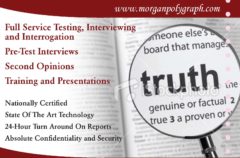
With the increasing demands for reliable deception detection in various sectors, you may wonder whether the polygraph remains the best tool for this purpose. While it has been a traditional method for assessing truthfulness, advancements in technology and psychology pose questions about its effectiveness and applicability in contemporary security settings. This blog examines into the reliability, limitations, and emerging alternatives to the polygraph, helping you understand its role in today’s complex landscape of deception detection.
Overview of Polygraphy
A polygraph, commonly known as a lie detector, measures physiological responses such as heart rate, blood pressure, and respiration to determine whether a person is being truthful or deceptive. Its applications range from criminal investigations to pre-employment screenings, aiming to shed light on the veracity of an individual’s statements. Understanding how polygraphy functions is vital for evaluating its effectiveness in today’s security landscape.
History of the Polygraph
An early version of the polygraph was developed in the early 20th century, with the first portable device created by John A. Larson in the 1920s. Its use expanded throughout the years, gaining traction with law enforcement and government agencies. Despite controversies surrounding its reliability, the polygraph remains a widely used tool in deception detection, evolving alongside advancements in technology and psychological research.
How Polygraphs Work
Above the surface, polygraphs function by recording physiological indicators that are believed to correlate with deceptive behavior. When you undergo a polygraph test, sensors attached to your body measure changes in your heartbeat, respiration, and perspiration as you respond to a series of questions.
Considering that a polygraph works through the assumption that deception triggers specific physiological responses, the test aims to establish a baseline for your normal behavior. During questioning, deviations from this baseline may indicate stress or discomfort, potentially suggesting deception. However, it’s crucial to recognize that individual responses can vary; factors like anxiety or medical conditions might also influence your physiological reactions. Hence, while polygraphs can offer insights, they are not infallible methods of deception detection.
Current Applications of Polygraph Testing
The polygraph, or lie detector test, finds various applications across multiple sectors today. You may recognize its use in criminal investigations, where it assists law enforcement in determining the veracity of statements made by suspects, witnesses, or victims. Additionally, it is often employed in government security clearances and certain private sector industries. Understanding these applications helps you assess whether the polygraph could play a role in your specific context.
Law Enforcement
To enhance investigative outcomes, law enforcement agencies often utilize polygraph testing as an adjunct investigative tool. You may find this method helps in evaluating the reliability of witness testimonies or identifying deceptive behaviors among suspects. While it is not a definitive proof of guilt, the information derived from these tests can assist in prioritizing leads and streamline the interrogation process.
Employment Screening
Before making hiring decisions, some employers implement polygraph tests as part of their employment screening process. You might encounter this practice particularly in roles requiring significant trust, like in defense, law enforcement, or sensitive financial positions. By assessing candidates’ honesty regarding qualifications, past experiences, or potential criminal behavior, employers aim to mitigate risks associated with hiring untrustworthy individuals.
It’s important to recognize that while polygraph testing can be a part of the employment screening process, its effectiveness in predicting future behavior remains a topic of debate. You should also be aware that its use is limited by legal regulations in many regions, and some candidates may view this process as invasive. Consequently, organizations often weigh the benefits against potential backlash when deciding to incorporate polygraph testing into their hiring practices.

Limitations of Polygraph Testing
Some of the key limitations of polygraph testing stem from its inherent complexity and susceptibility to various external factors. While often considered a tool for detecting deception, the polygraph can produce inconclusive or misleading results, which raises concerns about its overall effectiveness in securing accurate assessments in sensitive situations.
Accuracy and Reliability Concerns
An important issue with polygraph tests is the accuracy and reliability of the results. Studies suggest that the accuracy of polygraph testing varies significantly, leading to potential false positives or negatives, which can affect crucial decisions based on the outcomes.
Psychological Factors Affecting Results
With polygraph testing, various psychological factors can influence the results, ultimately impacting your assessment. Factors such as anxiety, stress, or even nervousness can cause physiological responses that could be misinterpreted as signs of deception. Understanding these factors is necessary for accurate interpretation.
- Your emotional state may trigger responses unrelated to truthfulness.
- Prior experience with polygraphs can affect performance and reactions.
- Differences in individual physiology contribute to variability in results.
For instance, a highly anxious person might exhibit heightened physiological reactions during questioning, even if they are telling the truth. Other psychological conditions, such as emotional instability, can lead to confusion during the test which might also skew results. It’s necessary to consider these factors to avoid misinterpretation of the polygraph readings.
- Persistent anxiety may inaccurately signal deception.
- Your background and personal experiences can influence test outcomes.
- Irregular physiological responses can mislead examiners.
Comparison with Alternative Deception Detection Methods
Many individuals question the efficacy of polygraphs when compared to alternative deception detection methods. Research indicates a variety of tools exist, each with distinct advantages and drawbacks. For a detailed look at various techniques in Detecting Lies, consider the following comparison:
| Method | Description |
|---|---|
| Polygraph | Measures physiological responses to determine truthfulness. |
| Voice Stress Analysis | Analyzes changes in voice patterns under stress. |
| Brain Imaging Techniques | Utilizes neuroimaging to observe brain activity related to deception. |
Voice Stress Analysis
Voice stress analysis evaluates vocal patterns to discern truthfulness. It focuses on variations in tone, pitch, and frequency, which can indicate stress or deceit. Although this method offers a non-invasive alternative, its accuracy is often debated in comparison to polygraph tests.
Brain Imaging Techniques
Stress indicators in brain activity can provide insight into deceptive behaviors, making brain imaging a cutting-edge tool. These techniques, including functional MRI and EEG, analyze areas of the brain activated during deception, potentially offering detailed information beyond physiological responses.
Detection through brain imaging techniques represents a burgeoning field that promises high levels of accuracy in identifying deceit. Researchers continue to explore the potential of these technologies in real-world scenarios, with ongoing studies examining their efficacy and reliability compared to traditional methods. As developments unfold, their role in security operations may offer enhanced capabilities for assessing truthfulness.
Case Studies and Real-World Effectiveness
To evaluate the polygraph’s efficacy in deception detection, several case studies provide insight into its performance:
- In a 2003 FBI study, polygraphs were used for pre-employment screenings, leading to a 30% reduction in hiring risks.
- A 2012 experiment revealed that polygraph testing had a 76% accuracy rate in differentiating truth-tellers from liars.
- In a notable criminal investigation, a 2018 case saw a 90% success rate in identifying deception regarding theft accusations.
Success Stories
After implementing polygraph tests in internal investigations, many organizations reported a significant increase in confession rates, with as much as 80% of individuals admitting to deception when confronted with results, showcasing its potential in enhancing truthfulness during inquiries.
Failures and Controversies
Beside its successes, polygraphs have faced criticism regarding their reliability. Some studies suggest that false positives can occur in up to 40% of cases, raising concerns about their validity in high-stakes situations.
Consequently, the controversial nature of the polygraph has led to debates about its reliance in legal and security frameworks. Critics argue that variations in individual physiological responses, along with the influence of psychological stress, can distort results. Additionally, the test’s underlying premise that deception triggers specific physical reactions remains under scrutiny, undermining its acceptance as a definitive tool for assessing truthfulness in critical scenarios.

The Future of Deception Detection in Security
Now, as the security landscape evolves, the future of deception detection hinges on advancements that integrate technology, psychology, and ethics. You can expect enhanced tools that go beyond current methodologies to provide more reliable insights into human behavior, shaping how security professionals assess trustworthiness in various contexts.
Technological Innovations
For you to stay ahead in the security domain, keeping an eye on emerging technologies like AI-driven video analytics and biometric systems is vital. These innovations promise to offer more accurate and efficient means of detecting deception, thereby reshaping your approach to security protocols and threat assessments.
Evolving Legal and Ethical Considerations
The landscape of legal and ethical considerations is also transforming as deception detection technologies grow. It’s important to recognize that the methods you choose for detecting deception must comply with emerging regulations and ethical guidelines, helping to establish fairness and transparency in security practices.
To navigate these evolving legal and ethical considerations, you must stay informed about laws governing privacy, consent, and data use. As society increasingly scrutinizes surveillance and manipulation techniques, ensuring that your practices align with ethical standards will not only protect individual rights but also enhance public trust in your security measures.
Final Words
On the whole, while the polygraph may be a widely recognized tool for detecting deception, its reliability and accuracy are subjects of debate in today’s security landscape. You should consider that, although it can provide insights, it is not infallible and should ideally be used in conjunction with other investigative methods to enhance your decision-making processes. As you navigate the complexities of deception detection, being aware of the polygraph’s limitations and exploring alternative techniques will enhance your effectiveness in ensuring safety and security.
